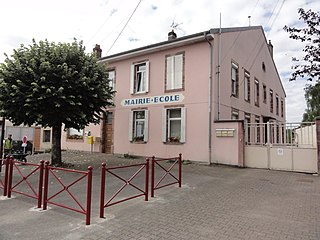
Arable land is any land capable of being ploughed and used to grow crops. Alternatively, for the purposes of agricultural statistics, the term often has a more precise definition:
Arable land is the land under temporary agricultural crops, temporary meadows for mowing or pasture, land under market and kitchen gardens and land temporarily fallow. The abandoned land resulting from shifting cultivation is not included in this category. Data for 'Arable land' are not meant to indicate the amount of land that is potentially cultivable.

Denmark is a Nordic country located in Northern Europe. It consists of the Jutland Peninsula and several islands in the Baltic Sea, referred to as the Danish Archipelago. Denmark is located southwest of Sweden and due south of Norway and is bordered by the German state Schleswig-Holstein to the south, on Denmark's only land border, 68 kilometres long.

Lozère is a landlocked department in the region of Occitanie in Southern France, located near the Massif Central, bounded to the northeast by Haute-Loire, to the east by Ardèche, to the south by Gard, to the west by Aveyron, and the northwest by Cantal. It is named after Mont Lozère. With 76,604 inhabitants as of 2019, Lozère is the least populous French department.

Population density is a measurement of population per unit land area. It is mostly applied to humans, but sometimes to other living organisms too. It is a key geographical term.

Zawiya, officially Zawia, is one of the districts of Libya. It is located in the north western part of the country, in what had been the historical region of Tripolitania. Its capital is also named Zawia. the province of Az Zawiya has three major municipalities; according to the new laws of local governance, includes Central Az Zawiya municipality, Southern Az Zawia municipality and Eastern Az zawiya municipality. In the north, Zawiya province has a shoreline bordering the Mediterranean Sea, while it borders Tripoli in east, Jafara in southeast, Jabal al Gharbi in south, Surman in the west.

Montmagny is a regional county municipality (RCM) in the Chaudière-Appalaches region of Quebec, Canada. Montmagny is the seat. Its neighbouring RCMs are Bellechasse, Les Etchemins, and L'Islet.

The districts of Peru are the third-level country subdivisions of Peru. They are subdivisions of the provinces, which in turn are subdivisions of the larger regions or departments. There are 1,838 districts in total.
Munesa is one of the Aanaas in the Oromia Regional State of Ethiopia. Part of the Arsi Zone located in the Great Rift Valley, Munesa is bordered on the south and west by the West Arsi Zone and Lake Langano, on the northwest by Batu Dugda, on the north by Tiyo, on the northeast by Digeluna Tijo, and on the east by Bekoji. The administrative center of the woreda is Kersa; other towns in Munesa include Ego.

Bouvesse-Quirieu is a commune in the Isère department in southeastern France.

Saint-Martin-de-Bavel is a commune in the Ain department in eastern France.
Saint-Léger-le-Petit is a commune in the Cher department in central France.

Maxilly-sur-Saône is a commune in the Côte-d'Or department in the Bourgogne-Franche-Comté region in eastern France. The inhabitants are called Maximilliens and Maximilliennes.
Champvoisy is a commune in the Marne department in north-eastern France. It is a rural municipality, with a very low population density. The municipality is part of the functional area of Reims, which is composed of 294 municipalities.

Thiébauménil is a commune in the Meurthe-et-Moselle department in Grand Est, France.

White Namibians are people of European descent settled in Namibia. The majority of White Namibians are Dutch-descended Afrikaners, with many of the White minority being German Namibians. Many are also Portuguese or English immigrants. Estimates published in 2016 suggest that the White Namibian population run between 75,000 and 150,000. This imprecision in data is because the Namibian government no longer collects data based on race.

Huyi District, formerly known as Hu County or Huxian, is one of 11 urban districts of the prefecture-level city of Xi'an, the capital of Shaanxi Province, Northwest China. The district was approved to establish from the former Hu County (户县) by the Chinese State Council on November 24, 2016. As of 2018, its population was 558,600. The district borders the prefecture-level cities of Xianyang to the north and Ankang to the south and Chang'an District to the east.
Peak farmland is the maximum usable amount of land needed for crop cultivation for a given region. Supporters of the peak farmland theory argue that even with the growing world population, the need for more farmland is decreasing, as food production yields per acre of farmland are rising faster than the global demand for food. This is supported by the fact that the area dedicated to farmland in some countries, both developed and developing, has already begun to decline. Globally, while the total amount of arable land is still increasing, the area of permanent pasture has been in decline since 1998, with at least 60 million hectares no longer grazed. It is argued that other countries, such as the United States, are at their peak farmland now.
Agricultural expansion describes the growth of agricultural land especially in the 20th and 21st centuries.












